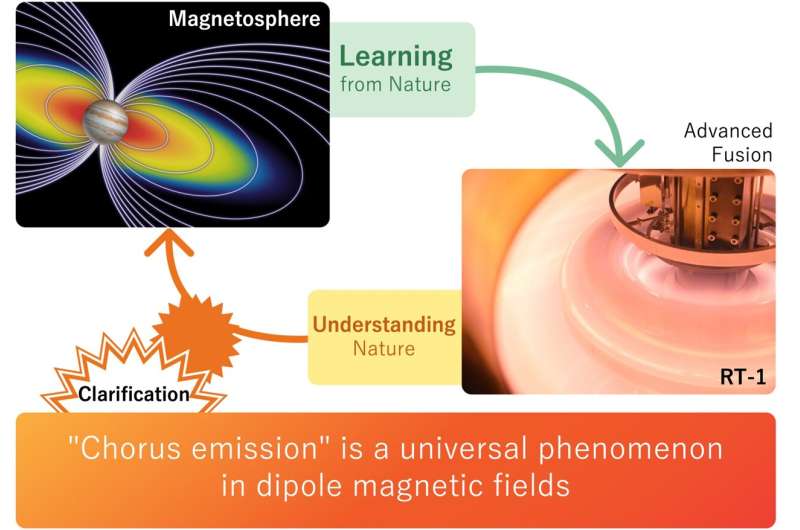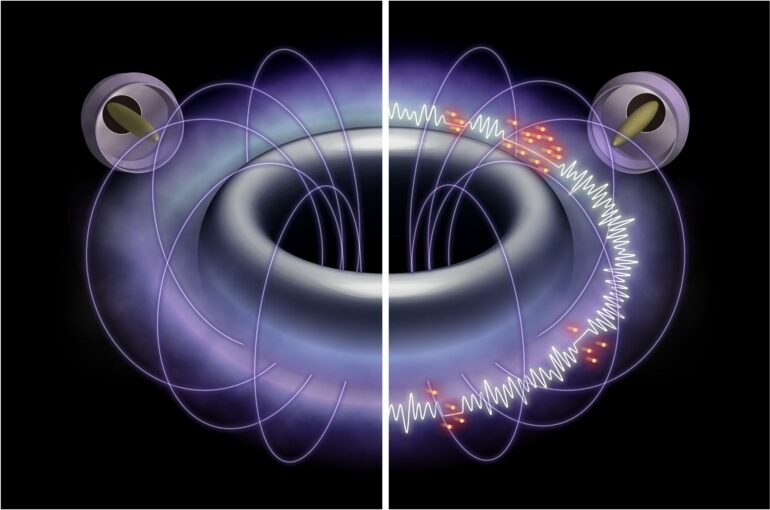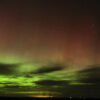A dipole magnetic field, created by a ring current, is the most fundamental type of magnetic field that is found both in laboratories and in space. Planetary magnetospheres, such as Jupiter’s, effectively confine plasma.
The RT-1 project aims to learn from nature and create a magnetosphere-type high-performance plasma to realize advanced fusion energy. Simultaneously, the artificial magnetosphere offers a means to experimentally understand the mechanisms of natural phenomena in a simplified and controlled environment.
The Ring Trap-1 (RT-1) is an experimental apparatus located at the University of Tokyo. Utilizing high-temperature superconducting technology, a dipole field coil is magnetically levitated, enabling plasma experiments to be conducted in an environment close to that of the planetary magnetosphere.
The whistler mode chorus emission, observed in the space surrounding the Earth, known as “Geospace,” is an important phenomenon that is related to the aurorae and space weather. The chorus emission has been actively investigated primarily through spacecraft observations, theoretical studies, and numerical simulations.

In the “artificial magnetosphere” RT-1, originally designed for an advanced fusion concept by drawing inspiration from nature, this study has conducted experiments to understand the natural phenomena and elucidate the conditions for the appearance of a “chorus emission” in space plasma. © National Institute for Fusion Science
While spacecraft are powerful tools for studying the actual space environment, the planetary magnetosphere is a huge and complex system that is difficult to understand in its entirety. Also, it is not easy for human beings to manipulate the space environment.
On the contrary, laboratory settings allow us to create a simplified research object that is extracted from the complex properties of nature in a controlled environment. Therefore, experimental studies are expected to play a complementary role in the observation and theory of understanding chorus emissions. However, it is not straightforward to create a magnetospheric environment in the laboratory. Laboratory experiments on chorus emissions in a magnetospheric dipole magnetic field have never so far been conducted.
A research team from the National Institute for Fusion Science in Toki, Japan, and the Graduate School of Frontier Sciences at the University of Tokyo in Kashiwa, Japan, has successfully conducted laboratory studies on the whistler mode chorus emission using the RT-1 device. This “artificial magnetosphere” has a magnetically levitated superconducting coil to create a planetary magnetosphere-type dipole magnetic field in the laboratory.
Using high-temperature superconducting technology, a 110 kg coil is magnetically levitated in a vacuum vessel, and the generated magnetic field confines the plasma. This unique setup allows operation without any mechanical support structures to the coil, making it possible to generate plasma in an environment akin to that of a planetary magnetosphere, even within a ground-based facility.
In this study, the research team filled the vacuum vessel of the RT-1 with hydrogen gas and injected microwaves to create high-performance hydrogen plasma, primarily by heating electrons.
In the experiments plasmas were generated in various states and investigations into the generation of waves were made. Consequently, a spontaneous production of the whistler wave chorus emission was observed when the plasma contained a considerable ratio of high-temperature electrons.
Measurements were also taken of the strength and frequency of the chorus emission from the plasma, focusing on its density and the state of the high-temperature electrons.
The findings, published in Nature Communications, revealed that the generation of a chorus emission is driven by an increase in high-temperature electrons, responsible for plasma pressure. Additionally, increasing the overall plasma density had the effect of suppressing the generation of the chorus emission.
Through this study, it was clarified that the chorus emission is a universal phenomenon occurring in plasma with high-temperature electrons in a simple dipole magnetic field. Properties revealed in the experiment, including appearance conditions and wave propagation, may enhance our understanding of the chorus emission and related phenomena observed in geospace.
Electromagnetic waves of a chorus emission have the potential to further accelerate hot electrons to higher energy states, leading to the formation of aurorae and satellite failures. These electromagnetic waves, along with energetic particles, play a crucial role in space weather phenomena.
In geospace, when explosive events (flares) occur on the solar surface, they give rise to magnetic storms, causing large fluctuations in the electromagnetic field and generating large amounts of energetic particles. This not only causes satellite failures and impacts the ozone layer but is also known to disrupt power and communication networks on the ground.
With the expansion of human activity today, understanding space weather phenomena has become increasingly important. However, numerous mechanisms and phenomena in this area remain unresolved. The outcome of this study is expected to contribute to a better understanding of the mechanisms behind the diverse space weather phenomena.
In the field of fusion plasma, which aims to ultimately solve energy problems, the loss of particles and structure formation due to interaction with waves is one of the central research issues. A precise understanding of the complex interactions between spontaneously excited waves and plasma is essential for achieving fusion.
Wave phenomena with frequency variations have been widely observed in high-temperature plasmas for fusion, indicating the existence of a shared physical mechanism with the chorus emission.
The findings from this study represent a step forward in comprehending the common physical phenomena found in both fusion and space plasmas. It is anticipated that future research will advance further with increased cooperation between these two fields.>
Whistler waves are one of the fundamental waves propagating in plasma. In chorus emissions observed around geospace and Jupiter, fluctuation events with frequency variations similar to birdsong occur repeatedly. They are thought to be closely related to aurorae and space weather phenomena, such as the production and transport of high-energy electrons.
More information:
Haruhiko Saitoh et al, Experimental study on chorus emission in an artificial magnetosphere, Nature Communications (2024). DOI: 10.1038/s41467-024-44977-x
Provided by
National Institutes of Natural Sciences
Citation:
Lab study creates artificial magnetosphere to explore spontaneous excitation of chorus emissions (2024, February 16)



